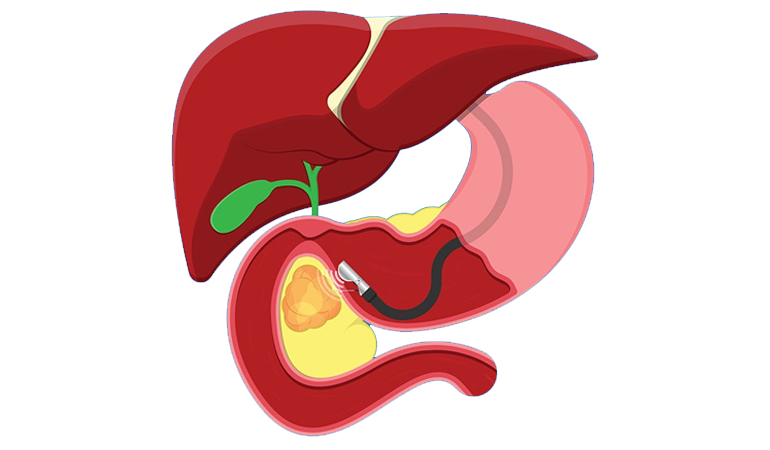Endoscopic Ultrasound in Ulwe, Navi Mumbai

What is Endoscopic Ultrasound ?
Endoscopic ultrasound (EUS) is a medical procedure that combines endoscopy and ultrasound imaging techniques to visualize and evaluate the gastrointestinal tract and nearby organs. It involves using an endoscope—a flexible tube with a light and camera on its tip—inserted into the body through the mouth or rectum to reach the targeted area.
Who needs an endoscopic ultrasound ?
An endoscopic ultrasound (EUS) is typically recommended for individuals who require further evaluation or diagnosis of certain medical conditions involving the gastrointestinal (GI) tract, pancreas, liver, or other adjacent organs.
- Evaluation of abdominal pain or unexplained weight loss
- Detection and staging of gastrointestinal cancers (e.g., esophageal, gastric, colorectal)
- Assessment of pancreatic diseases (e.g., pancreatitis, pancreatic cysts, pancreatic tumors)
- Diagnosis and staging of lung cancer
- Evaluation of submucosal lesions or tumors in the GI tract
- Investigation of bile duct disorders or gallbladder diseases
- Drainage of fluid collections or pseudocysts in the abdomen
- A sampling of lymph nodes for staging purposes or to determine the cause of an enlarged lymph node
- Assessment of the blood vessels surrounding the GI tract or liver
- Evaluation of rectal conditions (e.g., rectal cancer, anal fistulas)
Some specific indications for a EUS include the following:
- EUS provides high-resolution, real-time images of the gastrointestinal tract and nearby structures, allowing for a detailed evaluation of abnormalities and precise localization of lesions.
- EUS is a minimally invasive procedure that can be performed on an outpatient basis.
- EUS combines ultrasound imaging and endoscopy, comprehensively evaluating the digestive tract and adjacent organs in a single procedure.
- EUS is particularly valuable for staging cancers and determining the extent of tumor involvement in nearby structures and lymph nodes.
- EUS allows precise targeting of suspicious areas or lesions for biopsies.
- EUS enables various therapeutic procedures, such as drainage of fluid collections (abscesses, cysts), injection of medications or local treatments, and placement of stents to alleviate obstructions in the gastrointestinal tract.
- EUS is performed under sedation, ensuring patient comfort throughout the examination.
- EUS can be used to evaluate conditions that previously required surgical exploration.
Benefits of an Endoscopic Ultrasound
Endoscopic ultrasound (EUS) offers several benefits in the diagnosis and management of gastrointestinal conditions:
Endoscopic ultrasound procedure:
During an endoscopic ultrasound (EUS) procedure, the patient is typically sedated to ensure comfort throughout the examination. The procedure involves using an endoscope, a long, flexible tube with a light, and a small ultrasound probe at its tip.
- Preparation: Before the procedure, the patient may be asked to fast for a certain period to ensure the stomach is empty. An intravenous (IV) line may be inserted to administer sedatives or other medications.
- Sedation: The patient is given sedatives through the IV line to induce a relaxed and drowsy state. A local anesthetic may sometimes be applied to the throat to numb the area.
- Insertion of the endoscope: The endoscope is carefully inserted through the mouth or anus, depending on the specific area being examined (upper GI tract or rectum). The patient's position may be adjusted to aid in the passage of the endoscope.
- Ultrasound imaging: Once the endoscope is in position, the ultrasound probe at its tip emits sound waves that create detailed images of the targeted organs and tissues. These images are displayed on a monitor and interpreted by the doctor performing the procedure.
- Fine-needle aspiration (FNA) or biopsy (if necessary): Sometimes, the doctor may use EUS guidance to perform additional procedures such as fine-needle aspiration or biopsy. This involves inserting a thin needle through the endoscope to collect tissue or fluid samples for further analysis.
- Completion of the procedure: Once the necessary imaging and additional procedures are performed, the endoscope is slowly withdrawn. The patient is monitored until the sedation wears off.
Here is a general overview of the steps involved in an EUS procedure:
Request Consultation
Call us Now
+919834753096